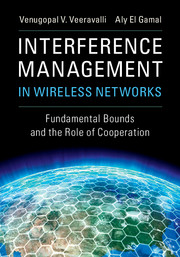Book contents
- Frontmatter
- Contents
- Preface
- Acknowledgments
- 1 Introduction to Interference Management
- 2 System Model and Sum Capacity Characterization
- 3 Degrees of Freedom and Interference Alignment
- 4 Iterative Algorithms for Interference Management
- 5 Degrees of Freedom with Coordinated Multi-Point Transmission
- 6 Locally Connected Channels with CoMP
- 7 Backhaul Load Constraint
- 8 Cellular Uplink
- 9 Dynamic Interference Management
- 10 Recent Advances and Open Problems
- Appendix A Information Theory
- Appendix B Algebraic Geometry
- References
- Index
Preface
Published online by Cambridge University Press: 09 February 2018
- Frontmatter
- Contents
- Preface
- Acknowledgments
- 1 Introduction to Interference Management
- 2 System Model and Sum Capacity Characterization
- 3 Degrees of Freedom and Interference Alignment
- 4 Iterative Algorithms for Interference Management
- 5 Degrees of Freedom with Coordinated Multi-Point Transmission
- 6 Locally Connected Channels with CoMP
- 7 Backhaul Load Constraint
- 8 Cellular Uplink
- 9 Dynamic Interference Management
- 10 Recent Advances and Open Problems
- Appendix A Information Theory
- Appendix B Algebraic Geometry
- References
- Index
Summary
Efficient interference management is the key to meeting the ever increasing demand for wireless data services in wireless networks. In this book, an information-theoretic framework for interference management is presented, along with a discussion of practically implementable schemes for interference management that approach provable bounds on performance and are applicable in large cellular networks.
A particular focus of the book is on exploiting recent technological advancements in the wireless infrastructure that enable cooperative transmission and reception. Our theoretical framework highlights the potential of this technology to deliver the rate gains promised by interference alignment, while using simple zero-forcing schemes that are easier to implement in practice. The schemes that we present rely on local cooperation, and they are shown to be optimal in locally connected interference networks, where the path loss effect allows us to neglect connections between transmitters and receivers that are far away from each other. It is also shown that cooperative communication can be used to deliver significant rate gains using simple zero-forcing with no or minimal extra load on the backhaul, by selecting cell associations and allocation of backhaul resources based on centralized processing and knowledge of the network topology. The insights obtained are also extended to dynamic interference networks that capture the effect of deep fading conditions.
This book is organized as follows:
• In Chapter 1, we provide a high-level introduction to interference management in wireless networks, including a historical perspective on wireless cellular networks, and we motivate the need for a fundamental information-theoretic understanding of this problem.
• In Chapter 2, we provide a detailed overview of the state of the art in determining the information-theoretic sum capacity of the interference channel. Determining the capacity even in the simplest setting with two users with one antenna at each of their transmitters and receivers is still an open problem, but exact results can be obtained in certain low-interference regimes that may arise in practice.
• In Chapter 3, we take an alternative approach to characterizing the rate of communication on an interference channel, based on a degrees of freedom (DoF) analysis, which is more analytically tractable. The DoF approach corresponds to analyzing the limiting normalized capacity as the signal-to-noise ratio goes to infinity, and the DoF measure emphasizes the loss in rate that results from the users interfering with each other over the effect of channel noise.
Information
- Type
- Chapter
- Information
- Interference Management in Wireless NetworksFundamental Bounds and the Role of Cooperation, pp. ix - xPublisher: Cambridge University PressPrint publication year: 2018
